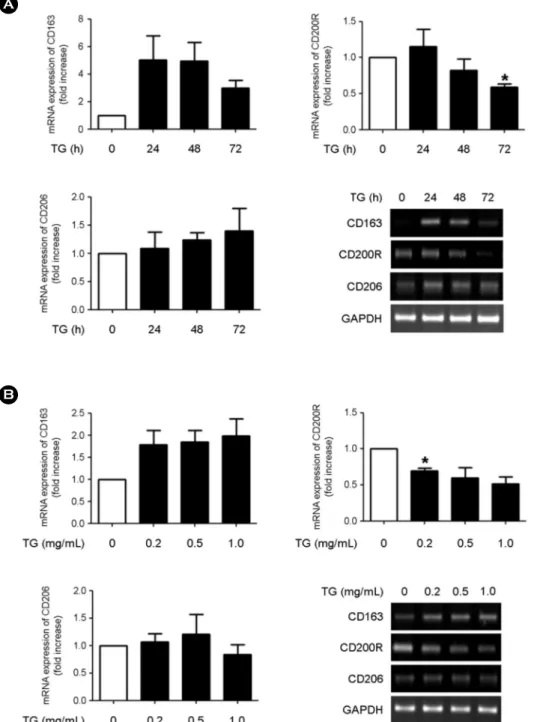Biomedical Science Letters 2016, 22(4): 220~226 http://dx.doi.org/10.15616/BSL.2016.22.4.220 eISSN : 2288-7415
Triglyceride Regulates the Expression of M1 and M2 Macrophage-specific Markers in THP-1 Monocytes
Hyun-Kyung Kim
1,2,§, Sung Hoon Kim
1,§, Yeo Wool Kang
1, Bohee Kim
1, Ki-Jong Rhee
1and Yoon Suk Kim
1,†1
Department of Biomedical Laboratory Science, College of Health Sciences, Yonsei University, Wonju, Gangwon-do 26493, Korea
2
Department of Biomedical Laboratory Science, College of Natural Science, Gimcheon University, Gimcheon, Gyungbuk 39528, Korea
Hypertriglyceridemia induces atherosclerosis and accordingly is a major causative factor in cardiovascular diseases.
Macrophages that develop into foam cells are a crucial component in the development of atherosclerosis. Monocytes can be differentiated into M1 or M2 macrophages. M1 macrophages promote inflammatory responses, whereas M2 macrophages exhibit anti-inflammatory activity. Recently, we found that triglyceride (TG)-treated THP-1 monocytes express a variety of macrophage-specific surface markers, indicating that TG treatment could trigger the differentiation of monocytes into macrophages. In this study, we investigated whether TG-induced macrophages express the M1 or the M2 macrophage phenotype. THP-1 cells were treated with various concentrations of TG for different times and the expression of M1- and M2-specific markers was evaluated by RT-PCR. We found increased expression of M1 markers (CD40, CD80, and CD86) in TG-treated THP-1 cells in a TG dose- and time-dependent manner. The expression of M2 markers (CD163, CD200R, and CD206) showed variable responses to TG treatment. Taken together, our results indicate that TG treatment triggers the differentiation of monocytes into M1 macrophages, rather than into M2 macrophages, suggesting that TG contributes to pro-inflammatory responses.
Key Words: Triglyceride, M1/M2 macrophage, Differentiation, Inflammation, Marker
INTRODUCTION
Atherosclerosis is a risk factor for cardiovascular diseases, such as myocardial infarction and stroke, which are major causes of adult deaths. Atherosclerosis is a chronic vascular inflammatory disease involving the formation of atheroma, i.e., the accumulation of lipid materials in the inner layer of the artery (Hirata et al., 2011). During development of athero-
sclerosis, macrophages develop into foam cells and become the main component in atherosclerotic plaques (Hansson, 2005).
Macrophages differentiated from monocytes can be div- ided into two types, M1 and M2, which express distinct phenotype-specific markers. M1 macrophages express M1- specific markers including CD40, CD80, and CD86, whereas M2 macrophages express M2-specific markers such as CD- 163, CD200R, and CD206 (Li et al., 2012; Panackal et al.,
Brief Communication
*Received: October 28, 2016 / Accepted: November 14, 2016
§These authors contributed equally to this manuscript
†Corresponding author: Yoon Suk Kim. Department of Biomedical Laboratory Science College of Health Sciences, Yonsei University Wonju 26493, Korea.
Tel: +82-33-760-2860, Fax: +82-33-760-2195, e-mail: yoonsukkim@yonsei.ac.kr
○CThe Korean Society for Biomedical Laboratory Sciences. All rights reserved.
○CCThis is an Open Access article distributed under the terms of the Creative Commons Attribution Non-Commercial License (http://creativecommons.org/licenses/by-nc/3.0/) which permits unrestricted non-commercial use, distribution, and reproduction in any medium, provided the original work is properly cited.
